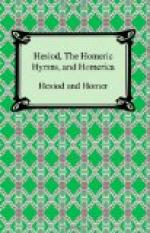The collection of thirty-three Hymns, ascribed to Homer, is the last considerable work of the Epic School, and seems, on the whole, to be later than the Cyclic poems. It cannot be definitely assigned either to the Ionian or Continental schools, for while the romantic element is very strong, there is a distinct genealogical interest; and in matters of diction and style the influences of both Hesiod and Homer are well-marked. The date of the formation of the collection as such is unknown. Diodorus Siculus (temp. Augustus) is the first to mention such a body of poetry, and it is likely enough that this is, at least substantially, the one which has come down to us. Thucydides quotes the Delian “Hymn to Apollo”, and it is possible that the Homeric corpus of his day also contained other of the more important hymns. Conceivably the collection was arranged in the Alexandrine period.
Thucydides, in quoting the “Hymn to Apollo”, calls it PROOIMION, which ordinarily means a `prelude’ chanted by a rhapsode before recitation of a lay from Homer, and such hymns as Nos. vi, xxxi, xxxii, are clearly preludes in the strict sense; in No. xxxi, for example, after celebrating Helios, the poet declares he will next sing of the `race of mortal men, the demi-gods’. But it may fairly be doubted whether such Hymns as those to “Demeter” (ii), “Apollo” (iii), “Hermes” (iv), “Aphrodite” (v), can have been real preludes, in spite of the closing formula `and now I will pass on to another hymn’. The view taken by Allen and Sikes, amongst other scholars, is doubtless right, that these longer hymns are only technically preludes and show to what disproportionate lengths a simple literacy form can be developed.
The Hymns to “Pan” (xix), to “Dionysus” (xxvi), to “Hestia and Hermes” (xxix), seem to have been designed for use at definite religious festivals, apart from recitations. With the exception perhaps of the “Hymn to Ares” (viii), no item in the collection can be regarded as either devotional or liturgical.
The Hymn is doubtless a very ancient form; but if no example of extreme antiquity survive this must be put down to the fact that until the age of literary consciousness, such things are not preserved.
First, apparently, in the collection stood the “Hymn to Dionysus”, of which only two fragments now survive. While it appears to have been a hymn of the longer type (15), we have no evidence to show either its scope or date.
The “Hymn to Demeter”, extant only in the Ms. discovered by Matthiae at Moscow, describes the seizure of Persephone by Hades, the grief of Demeter, her stay at Eleusis, and her vengeance on gods and men by causing famine. In the end Zeus is forced to bring Persephone back from the lower world; but the goddess, by the contriving of Hades, still remains partly a deity of the lower world. In memory of her sorrows Demeter establishes the Eleusinian mysteries (which, however, were purely agrarian in origin).




